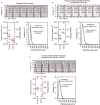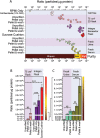How pure are your vesicles?
- PMID: 24009896
- PMCID: PMC3760653
- DOI: 10.3402/jev.v2i0.19861
How pure are your vesicles?
Abstract
We propose a straightforward method to estimate the purity of vesicle preparations by comparing the ratio of nano-vesicle counts to protein concentration, using tools such as the increasingly available NanoSight platform and a colorimetric protein assay such as the BCA-assay. Such an approach is simple enough to apply to every vesicle preparation within a given laboratory, assisting researchers as a routine quality control step. Also, the approach may aid in comparing/standardising vesicle purity across diverse studies, and may be of particular importance in evaluating vesicular biomarkers. We herein propose some criteria to aid in the definition of pure vesicles.
Keywords: extracellular vesicles; nano-particle tracking; sample purity; vesicle counting.
Figures



References
-
- Duijvesz D, Luider T, Bangma CH, Jenster G. Exosomes as biomarker treasure chests for prostate cancer. Eur Urol. 2011;59:823–31. - PubMed
-
- Alvarez-Erviti L, Seow Y, Yin H, Betts C, Lakhal S, Wood MJ. Delivery of siRNA to the mouse brain by systemic injection of targeted exosomes. Nat Biotechnol. 2011;29:341–5. - PubMed
-
- Théry C, Amigorena S, Raposo G, Clayton A. Isolation and characterization of exosomes from cell culture supernatants and biological fluids. Curr Protoc Cell Biol. 2006;Chapter 3:UNIT 3.22. - PubMed
-
- Papp K, Vegh P, Prechl J, Kerekes K, Kovacs J, Csikos G, et al. B lymphocytes and macrophages release cell membrane deposited C3-fragments on exosomes with T cell response-enhancing capacity. Mol Immunol. 2008;45:2343–51. - PubMed
LinkOut - more resources
Full Text Sources
Other Literature Sources

